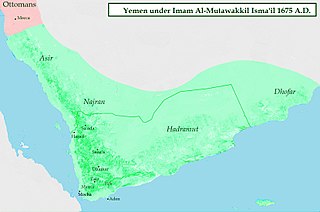Related Research Articles

The Imams of Yemen and later the Kings of Yemen were religiously consecrated leaders belonging to the Zaidiyyah branch of Shia Islam. They established a blend of religious and secular rule in parts of Yemen from 897. Their imamate endured under varying circumstances until the republican revolution in 1962. Zaidiyyah theology differed from Ismailis or Twelver Shi'ites by stressing the presence of an active and visible imam as leader. The imam was expected to be knowledgeable in religious sciences, and to prove himself a worthy headman of the community, even in battle if this was necessary. A claimant of the imamate would proclaim a "call" (da'wa), and there were not infrequently more than one claimant. The historian Ibn Khaldun mentions the clan that usually provided the imams as the Banu Rassi or Rassids. In the original Arab sources the term Rassids is otherwise hardly used; in Western literature it usually refers to the Imams of the medieval period, up to the 16th century. The Rassid branch that came to power with imam al-Mansur al-Qasim is known as Qasimids.

The Tahirids were an Arab Muslim dynasty that ruled Yemen from 1454 to 1517. They succeeded the Rasulid Dynasty and were themselves replaced by the Mamluks of Egypt after only 63 years in power.

The Imams of Yemen and later the Kings of Yemen were religiously consecrated leaders belonging to the Zaidiyyah branch of Shia Islam. They established a blend of religious and secular rule in parts of Yemen from 897. Their imamate endured under varying circumstances until the republican revolution in 1962. Zaidiyyah theology differed from Isma'ili or Twelver Shi'ites by stressing the presence of an active and visible imam as leader. The imam was expected to be knowledgeable in religious scholarship, and to prove himself a worthy headman of the community, even in battle if this was necessary. A claimant of the imamate would proclaim a "call" (da'wa), and there were not infrequently more than one claimant.
Al-Mu'ayyad Muhammad was an Imam of Yemen (1620–1644), son of Al-Mansur al-Qasim. He managed to expel the Ottoman Turks entirely from the Yemenite lands, thus confirming an independent Zaidi state.
Al-Mutawakkil Ahmad (26), September 1756 - 10 September 1816 was an Imam of Yemen who ruled in 1809-1816. He belonged to the Qasimid family, descendants of the Prophet Muhammad, which dominated the Zaidi imamate of Yemen from 1597 to 1962.
Al-Mansur Ali II (1812–1871) was an Imam of Yemen who reigned in the capital San'a during four brief terms. He belonged to the Qasimid family, descended from the Islamic prophet, Muhammad, which dominated the Zaidi imamate of Yemen from 1597 to 1962.
An-Nasir Abdallah was an Imam of Yemen who ruled in 1837-1840. He was a member of the Qasimid family, descendants of Muhammad, which dominated the Zaidi imamate of Yemen from 1597 to 1962.
Al-Mutawakkil Muhammad was an Imam of Yemen who reigned from 1845 to 1849. He belonged to the Qasimid family, descended from the Islamic prophet, Muhammad, which dominated the Zaidi imamate of Yemen from 1597 to 1962.
Al-Hadi Sharaf ad-Din was a claimant for the Zaidi imamate of Yemen in the years 1878–1890, acting in opposition to the Ottoman occupiers of the country. His period saw a tribal embryo of a state taking form in the highlands of Yemen, which would be strengthened by his successors as imams, and eventually usher into the expulsion of the Ottoman Turks in the early 20th century.
Muhammad bin Yahya Hamid ad-Din was an Imam of Yemen who led the resistance against the Ottoman occupation in 1890–1904.
Al-Mutahhar was an imam of the Zaidi state of Yemen who ruled from 1547 to 1572. His era marked the temporary end of an autonomous Yemeni polity in the highlands.
Al-Mansur Ali bin Salah ad-Din (1373–1436) was an imam of the Zaidi state in Yemen who ruled in 1391–1436, partly in rivalry with other claimants to the imamate.
Al-Mutawakkil Yahya Sharaf ad-Din was an imam of the Zaidi state in Yemen. His period as imam covered the period from 1506 to 1555, though his political power ended in about 1547.
Al-Mansur Muhammad was an imam of the Zaidi state in Yemen who ruled in 1475-1504, in rivalry with other claimants for the imamate.
An-Nasir al-Hasan was an imam of the Zaidi state in Yemen, who exerted a limited authority in the northern Yemeni highland in 1495-1523.
Al-Mansur Abdallah, was an imam of the Zaidi state in Yemen who held the imamate from 1187 to 1217.
Al-Mansur al-Husayn III was a claimant to the dignity of imam of Yemen in 1859-1863, wielding power in intense rivalry with other self-proclaimed imams.
Al-Mansur al-Hasan (1199–1271) was an imam of the Zaidi state of Yemen who ruled in 1262-1271.
An-Nasir Muhammad bin Yusuf was a contender for the Zaidi state in Yemen, whose term as imam is counted from 1474 to 1488.

The Yemeni Zaidi State, also known as the Zaidi Immamate and the Qasimid State, was a Zaidi-ruled independent state in Greater Yemen region, which was founded by al-Mansur al-Qasim in 1597 and absorbed much of the Ottoman Yemen Eyalet by 1628 and completely expelled the Ottomans from Yemen by 1638. The Zaidi state continued to exist into 18th and 19th century, but gradually fractured into separate small states. The most notable of those states was the Sultanate of Lahej; most of those states were submitted by the Ottomans and incorporated into the restored Ottoman province of Yemen Eyalet in 1849.
References
- ↑ Encyclopaedia of Islam, Vol. VII, Leiden 1993, p, 996.
- ↑ Michel Tuchscherer, 'Chronologie du Yémen (1506-1635)', Chroniques yémenites 8 2000, http://cy.revues.org/11 .
- ↑ Robert W. Stookey, Yemen; The Politics of the Yemen Arab Republic. Boulder 1978, p. 141. His date of capture is also given as 1596/97, which appears to be incorrect.
| Vacant Title last held by al-Mutahhar | Zaydi Imam of Yemen 1579–1585 | Vacant Title next held by al-Mansur al-Qasim |